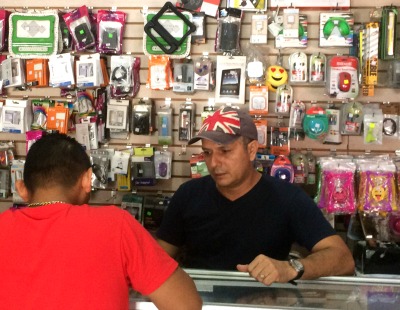
They also sell technology and accessories, such as:
Cell Phones, cases, chargers, power banks, routers, modems, mouse(s) (“Mice?”), all sorts of computer and electronic accessories, as well as watches and sunglasses.
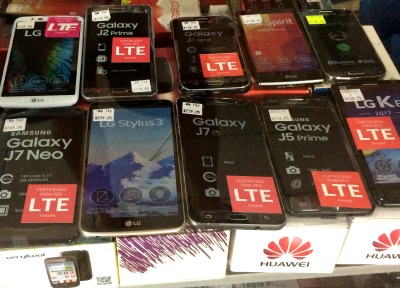
You used to be able to buy clothing and shoes there too, but no more. It is only a cell phone/tech store now.
Repairs Available
They also do repairs on cell phones, computers, and watches. See below for more on the repair crew.
On the main street, 150 meters down from Romero Supermarket, on the same side of the street. (see map)
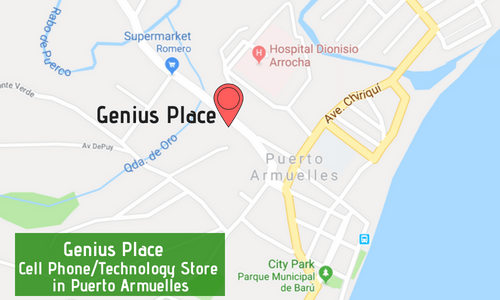
Open Monday - Saturday: 9am - 7pm. Closed Sundays.
Phone: 770-8024
I asked him how he came to name his business, Genius Place.
Where I come from, this would be an invitation for a lot of sarcastic comments.
Nextali explained that the name was “discovered” during the remodel of the building, before the store had even opened.
Nextali and the guys doing the remodel kept giving one another a hard time. “Oh thank you for passing me the nails…You’re a genius!” or “Hey Genius, can you help me move this scaffolding?” “No, you are the genius; I am but a humble assistant”, etc…
So that is how this useful and conveniently located store got it's name.
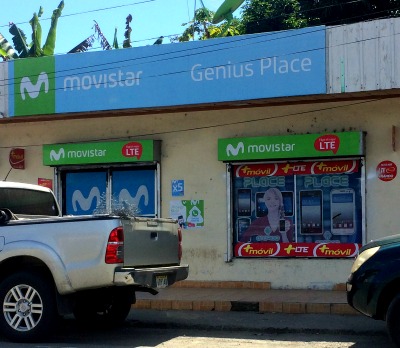
In 2003, Chiquita Banana Company closed its operations here in Puerto Armuelles for good. So, what does a company town do after the company has left the town behind?
Many people leave. But the loss of Chiquita Banana also enabled many entrepreneurs to start up businesses at bargain basement prices.
One such businessman is Nextali Montenegro, owner of Genius Place.
Nextali is from Paso Canoas, the town at the Costa Rica–Panama border, about 35 kilometers north of Puerto Armuelles.
Nextali's family has a long history in the retail business, having run successful clothing shops in Paso Canoas for more than a generation. After Nextali finished his university studies in business administration, he wanted to expand the family’s businesses into new markets. When he was 22 years old, Nextali saw Puerto Armuelles as the perfect opportunity to “get in on the ground floor.”
It has worked out well for him. Nextali owns the entire building where his shop is located, including the Uno Express courier service and the beauty supply store. So, as the market improves, Genius Place is poised to expand at their own pace. Genius Place has a second location in Bugaba, near the central park, and they have plans to open a shop in Volcan in the next several months.
Nextali is happy about the arrival of Del Monte in Puerto. Obviously, having so many new jobs in Puerto Armuelles is great for his cell phone business, since the cell phone, more than any other product, after food and shelter, is what working class Panamanians spend their money on. It’s the same all over the world.
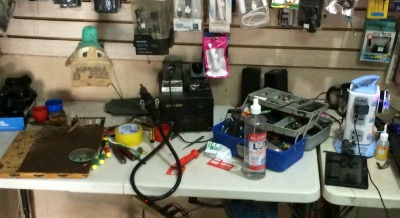
Nextali has two employees currently. Joel Aparicio, 29, is a graduate in cellular and computer technology and repair. He can definitely answer any of the usual questions that customers may have.
Joel is always eager to improve his English skills by working with ex-pat customers. However, his English skills are just fine for communicating and assisting with any computer/phone tech questions.
Kevin De Leone is 30. He is also a tech “geek”. Both he and Joel have their own work desks where they solder and repair cell phones, and many other repairs that come through the door. Kevin is not an English speaker. However, his good nature is apparent. There is certainly an air of good will and cooperation in the shop, much of it due to these 2 guys.
To give you an idea of the kinds of products and services that bring me, personally, to Genius Place, here’s an example. The other day, when I went into the shop to do the interview for this article, I realized that I had a couple of cell phone related tasks to accomplish while I was there.
First, I needed a new battery for one of our cell phones. “No Problem”, I was told. Within 5 minutes the new battery was installed.
Then, I remembered that I also needed to buy a power bank for another phone, an old iphone with a battery that barely held a charge anymore. They had several power banks to choose from.
I also needed assistance installing internet data on my cell phone. Nextali took care of this for me.
The final task may amaze some of you, if you are even reasonably tech savy. I had installed Whats App on my phone, but I could not remember how to use all its features. (To be honest, I forgot how to use WhatsApp completely.….I know. My wife Betsy, and especially my two daughters, give me no end of grief for being so technologically hopeless).
“No Problem”, I was told. Nextali explained to me, once again, all the features and how to use them. "Pan Cocido" (A piece of cake). Better yet, if I had asked any of the women in my family for help, they would have given me such a hard time for being such an “old fuddy duddy” that it would not have been worth asking for help. Nextali didn’t tease me once.
Check out Genius Place next time you need help with your technology.
Read my wife's article to get the basics about your cell phone and service options in Panama.
Find out more about life in Puerto Armuelles. Sign up for our monthly Living in Panama Newsletter.
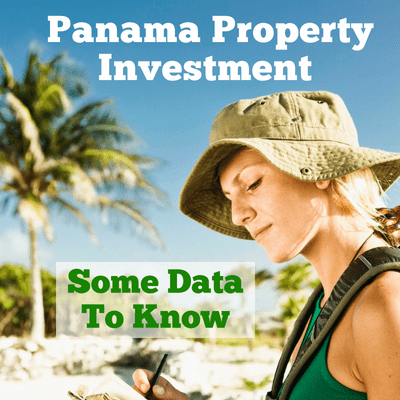
Here it is:
Foreign buyers are pushing up property prices in Panama. The average dwelling sales price surged by 21% from January 2015 to June 2017 in Panama's metropolitan area, according to the Panamanian Chamber of Construction (Capac) as reported by La Estrella de Panama.
Foreign buyers tend to be from the United States, Europe, Canada, and Latin America.
Yet at US$2,050 per square meter (sq. m.) in June 2017, the average price of residential properties in Panama still looks very reasonable, with metropolitan prices ranging widely from US$ 928 to US$ 2,892 per sq. m., according to Capac.
In Punta Pacifica, a collection of exclusive waterfront skyscrapers, high-end apartment prices are rising by 6% to 12% per annum, due to a shortage of available units. The average price in Punta Pacifica stood at around US$ 2,300 per sq. m. as end-2017.
Sales and construction were both up in 2017, says Maria Arias of TDI Real Estate. Arraiján and La Chorrera, where property prices start at around US$30,000, are specially active, due to infrastructure developments in Panama West and Panama East's constant growth.
It is a big turnaround. After the global financial crisis in 2008, Panama's dwelling prices declined by an average of 20% to 30%, according to Kent Davis of Panama Equity Real Estate.
Only after 2012 did foreign buyers return to the market.
Now it is the opposite story. Many infrastructure projects are approaching completion, and Panama's economy will continue to accelerate in 2018 and 2019.
Another boost to the market will be the new property tax law to be implemented from January 2019, which gives tax exemption to all primary residences worth more than US$ 120,000 (previously US$30,000), and generally reduces property tax rates.
Read about the new Panama property tax law
Tourist arrivals rose by 7.5% to about 2.5 million people in 2017, says the Panama Tourism Authority, with European visitors up 8.1% (though tourist spending only rose 3.8% to US$ 4.5 billion in 2017).
According to the Panama Tourism Authority, these numbers are expected to rise further since Air China now has direct flights to Panama. This will attract Chinese tourists.
Foreigners can own real properties in Panama, and are accorded with the same property rights as Panamanians. However, mortgages can be difficult to obtain, especially for foreigners, and the purchase process can take two to three months. More than 80% of real estate transactions involving foreign buyers are in cash.
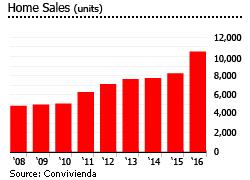
Beach apartments are increasingly in demand by both local and foreign buyers. The most popular areas include Punta Chame, Playa Blanca, Farallon, El Palmar (Hato River), Santa Clara, and Rio Mar (San Carlos).
Demand is supported by a stronger mortgage market. "The improvement in conditions for residential mortgages in recent years has been the principal promoter for housing," says the Superintendencia de Bancos de Panamá. Residential mortgages granted rose 10.1% to PAB 14.08 billion (US$ 14.13 billion) in 2017, as low interest rates and higher average terms increased the purchasing power of families. The interest rate on housing loans was 5.5% in December 2017, unchanged from the same period last year.
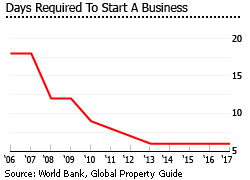
It requires only six days to start a business in Panama, according to the World Bank’s 2017 survey. Panama is the 2nd most competitive country in Latin America and the Caribbean, according to the World Economic Forum's Global Competitiveness Report 2017-2018.
Panama draws multinational companies and foreign investors with significant tax breaks, the free-trade zone, improved infrastructure, and a low cost of living. The expansion of the Panama Canal, which was opened in June 2016, is expected to bring in over US$2 billion in annual revenues by 2021.
“There are so many new businesses moving to Panama,” said Kent Davis of Panama Equity Real Estate. “It’s one of the reasons people are coming down – because there is still money to be made, locally, and as a regional base of operations.”
“People aren’t just moving here to relax,” Davis added. “They’re coming here to work because there is so much business around.”
Panama encourages foreign direct investment (FDI) in real estate by offering various incentives such as property tax exemptions, according to Jeff Barton of Punta Pacifica Realty.
Panama has the highest foreign direct investment (FDI) share of GDP in Latin America, at more than 10% of GDP, according to a United Nations report. Panama is also the largest recipient of FDI in Central America, with 44% of 2016's regional FDI total of US$ 11.97 billion. In 2017, the country's FDI rose by about 1.8% to about US$ 5.319 billion from the previous year, according to the Comptroller General of the Republic of Panama.
"The international community recognizes that Panama is a stable democracy and it is the fastest-growing country in Latin America," said Economy and Finance Minister Dulcidio De La Guardia.
For what it is worth, International Living’s Global Retirement Index names Panama as one of the world’s best places to retire in 2018, due to its convenience (ease of access from US, currency in US dollars, English is widely understood), world-class amenities, good beaches, and affordability.
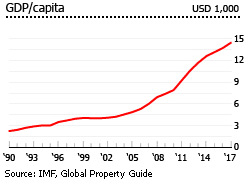
Panama has been removed from Financial Action Task Force's (FATF) "grey list", but money-laundering is still rampant.
In June 2014, Panama was placed on the "grey list" of Financial Action Task Force (FATF) of countries not doing enough to fight money laundering. FATF officially took Panama off its money laundering and terrorism financing watch list in February 2016, after new government regulations.
Despite this, money laundering and terrorist financing are believed still rampant in Panama. No real controls prevent funds moving through Panama to terrorist organizations, nor are do money laundering prosecutions actually take place. Moreover, Panama's powerful criminal syndicates remain fully operational.
In a recent report by the Latin America Financial Action Task Force (Grupo de Acción Financiera de Latinoamérica – GAFILAT), GAFILAT noted that the government's anti-laundering efforts are good, signalling progress in fighting money laundering. However, the report also pointed some deficiencies that the government must work on.
According to the GAFILAT report, the country was observed to be more susceptible to illicit streams of revenue from foreign sources than domestic ones. The GAFILAT enumerated the sectors of real estate, banking and corporate services, and free trade zones as the most vulnerable sectors to money laundering.
The task force also identified almost 730,000 businesses in the country that are considered at "high risk" of partaking in money laundering, during its investigation in May 2017.
Panama City is divided into two main areas – the old colonial town of Casco Viejo, and the modern business and shopping district of high-rise buildings and malls.
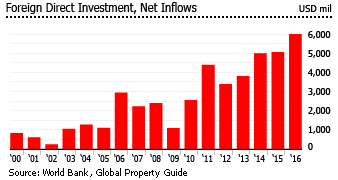
Panama's gross rental yields are still good, despite having declined over the past few years. Rental yields are range from 5.7% to 7.3%, with smaller apartments tending to yield more, based on the Global Property Guide research in November 2016.
Most properties in Panama City are apartments.
Based on the figures from Encuentra24, 2016 apartment prices in Panama City were:
Inland apartments ― ranging from US$ 1,900 per sq. m. to almost US$ 2,500 per sq. m.
Beachfront apartments ― ranging from US$ 1,800 per sq. m. to US$ 3,600 per sq. m.
Boquete, in Panama’s mountain highlands, has a fast growing expatriate community. The popular option here is to buy land and build a home, but there are many completed homes on offer.
Sample property prices for Boquete are as follows:
2-bedroom, 1-bathroom home, about 1,600 sq. ft. – US$90,000
3-bedroom, 2-bathroom home, about 1,500 sq. ft.– US$179,000
Another desirable location is Coronado, a popular beach town and relaxed community for expats, and only an hour from Panama City.
Sample property prices for Coronado are as follows:
3-bedroom, 2-bathroom home, about 1,300 sq. ft. – US$132,000
2-bedroom, 1-bathroom furnished condo, about 850 sq. ft. – US$135,000
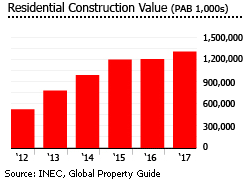
In 2017, the value of residential construction rose by 12.2% to PAB 1.29 billion (US$ 1.29 billion) from the previous year, when it rose by 0.6%m, after annual increases of 21.1% in 2015, 26.8% in 2014, and 48.8% in 2013, according to the Instituto National de Estadistica y Censo (INEC), all of which follows a decade of breakneck building which raised occupied housing units by 31.5% between 2000 and 2010, according to the National Censuses.
Total credits granted to the construction sector rose by 8.2% In 2017 to around PAB 6.74 billion (US$ 6.77 billion), according to Superintendencia de Bancos de Panamá.
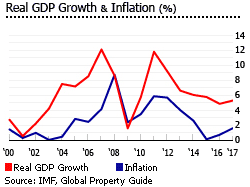
"This increase is explained primarily by the behaviour of economic activities related to the external sector. Among them, those of the Panama Canal, air and financial services stand out positively," noted a recent report of the Comptroller General of the Republic.
The US$5.25 billion expansion of the Panama Canal, which began in 2007, has experienced delays and cost overruns amounting to US$1.6 billion. But the expansion, which started operations in June 2016, has doubled the Panama Canal's capacity, with wider and deeper lanes and locks, and a new lane of traffic allowing more and larger ships. This year's tonnage of 403.8 million Panama Canal tons (PC/UMS) was the highest in its history, and a 22.2% increase on last year.
"These record figures reflect.... the Panama Canal’s continued ability to transform the global economy and revitalize the maritime industry," says Panama Canal's administrator, Jorge L. Quijano.
Major infrastructure projects scheduled to finish this year or in early 2019 include Panama’s metro system, the first in Central America. Line 1 was completed in April 2014, while the second line is expected to be completed in 2018.
The port of Colon upgrade is expected to be completed by the end of 2018, while the construction of the second Tocumen International Airport is currently in its final phase.
All these major infrastructure projects will improve the country’s connectivity, and breathe new life to the economy and the real estate market.
The economy is expected to expand by 5.6% this year, and further accelerate by 5.8% in 2019, according to the IMF.
After more than 10% annual GDP growth in 2011-2012, Panama’s economy slowed to 6.9% in 2013, 5.1% in 2014, 5.6% in 2015, and 5% in 2016, according to the National Institute of Statistics and Census (INEC).
The more moderate pace of recent growth reflects work delays at the Panama Canal (from August 2014, the completion date moved several times to June 2016), and the end of other public work projects, and the Colon Free Zone dispute with Venezuela and Colombia.
I have edited this Global Property Guide article slightly to make it easier to read.
Source: GlobalPropertyGuide.com
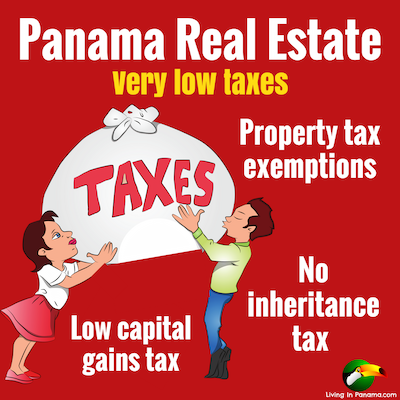
But, yes, there are real estate-related taxes in Panama.
In this post, I cover real estate-related taxes as follows: property, sales, transfer, capital gains, rental income, and gift taxes in Panama.
As you may have heard, Panama has radically revised its property tax system. It goes into effect on January 1, 2019.
Through 2018, if your Panama property is valued at or under $30,000, your property is completely exempt from property tax. In 2019, that exemption surges up to $120,000.
Learn about the current 2018 property tax rates and rules
Since most property in Panama is valued at under $120,000, most real estate in Panama will have zero property tax. Keep in mind, this exemption only applies to your primary residence.
Own 1 Property? If you only own one property in Panama, regardless of anything you own outside of the country or how much time you spend in Panama, Panama views that property as your primary residence.
Own Multiple Properties? If you own more than 1 Panama property, all but your primary residence will be taxed at the investor rate (see below). This rate is still a 50% reduction from the old Panama property tax rate. And even those properties enjoy an exemption on the first $30,000 of value.
Primary Residence Property Tax Rates
A property tax example. Say you buy your house for $350,000. You would pay property tax on $230,000 ($350,000 - $120,000) at a rate of .5%. Which means you would owe $1,150 in property taxes a year.
Investor Property Tax Rates
This "investor" rate applies to secondary residences, commercial and industrial properties.
A property's registered value is the same as the sales price. The registered value will only get updated when you sell the property. Panama has no property assessors.
ANATI is the government department that keeps records of a property's registered value. Keep in mind, only titled property is registered; and therefore, has a registered value.
Right of Possession (ROP) properties do not pay property taxes. And most property in Panama is ROP..
Most people don't title their ROP property because of cost. Not only does it cost money to title, but once you title, you are required to pay property taxes.
Learn more about ROP property.
For many people, especially Panamanians, there is little reason to title their ROP property. Titling means they will have to pay a lawyer and the government a chunk of change. And then property taxes every year after that.
But the Varela government really wants to rid Panama of its informal ROP property system. It wants to modernize its land system to include better centralized tracking and to allow for better protections of property owners.
Enter the new property tax law. The new law slashes property tax rates. Most critically, it exempts properties valued at up to $120,000 from paying any property tax whatsoever. As I've mentioned, the vast majority of real estate in Panama is under $120,000.
The Varela government is doing all it can to get property titled. It has even created mobile ANATI offices to travel around Panama to help ROP property owners to title their property. Time will tell how effective the new property tax law & government efforts are at nudging people to title their ROP homes.
Panama is also under pressure from the World Bank and other lending institutions to do a better job at collecting the millions of dollars of unpaid property taxes.
Given that Panama does a terrible job at collecting property taxes, it won't be hard to show improvement.
Many, maybe most, property owners in Panama don't pay their property taxes until they sell.
That is only time the government tries to collect property taxes - at the point of sale. At that time, the seller not only has to pay all unpaid property taxes, but all the fines accrued for the late payments.
Notification of Taxes Owed
Of course, not paying your property tax in Panama is an easy thing to do. Property owners never receive a bill or reminder to pay the tax. No instructions are given on how to pay property taxes at the time of purchase. So unless you remind yourself, it is easy to forget to pay. (FYI Panama property taxes are due 3 times a year: April, August and December.)
Starting in 2019, Panama will likely try to develop some kind of property tax-notification system. The easiest way, for those with a mortgage loan, is to partner with banks to notify owners.
However, most expats do not have mortgages. And given Panama's lack of a postal system, it is unclear how property owners with no mortgages will be notified of their tax bills. The electric company in my town, slips my power bill into my fence. But that does not seem like a viable option for ANATI. And regardless, it is certainly not a good "system". (Find out how to pay your utilities in Panama)
Panama’s has had a famous tax exoneration law.
In 2008, it allowed for a 20-year tax exoneration for properties which were built prior to January 1, 2012. Then, in 2012, the tax exoneration rules changed. You could get a property tax exoneration for houses or condos built after 2012. But not a 20 years exoneration, depending on the price, the tax exoneration varied from 5 to 15 years.
Panama's tax exoneration program ends on January 1, 2019; the same date the new property tax system comes into play.
However, if you own a property that is currently built and has an exoneration, then you are good.
And if you buy a property that has a tax exoneration, you are good too. The exoneration remains with the building, not the owner. So it can be transferred from one owner to the next.
Keep in mind, the tax exoneration only applies to the improvements or construction. You will still need to pay taxes on the land.
As far as registering improvements, you need to file the value. This is done as part of the construction permit process. That is what constitutes “mejoras,” (improvements). Improvements can still be exonerated from taxes, but the filing must be done before the law changes in 2019.
Remember, after the exoneration law ends, $120,000 of your property's value will be fully exempt from property taxes.
As I mentioned above, the seller must pay any unpaid property taxes upon the sale of the property.
At the time of purchase, the following taxes must also be paid:
The capital gains tax is a little complicated. The seller will initially be charged, and must pay, 3% of the sales price. After this payment, if 10% of the actual gain is less than 3% of the sales price, the seller can then apply to the government for a refund for the difference. However, getting this refund takes time. But I know of people who have been successful.
Technically, you are supposed to include your capital gains as part of your income tax return. But that is not generally done, and you will not be penalized for not doing so.
(FYI Most expats do not file an Panama income return. You are only required to file an income tax return if you earn income in Panama. Keep in mind, income earned online, even while you are in Panama, does not count as income earned in Panama.)
Using A Corporation
If you form a corporation to buy or sell property, you don't pay a title transfer and capital gains tax.
However, you are then required to pay a 5% share transfer tax. Tax-wise it is usually a wash. You effectively pay the same amount of tax. And you lose out on getting a refund if your capital gain is less than 3% of the sales price.
In addition, you also have to pay to create a corporation and then pay an annual fee to keep it current. However, as in every country, you do gain protections from having your property in a corporation's, rather than in your own, name. (Read about the dangers of buying from a corporation)
Purchase The Corporation Instead?
If the property is owned under a corporation and the registered value of the property is significantly lower than your purchase price, you should consider purchasing the corporation. This is because, for tax purposes, the registered values do not update when the shares of the corporation are sold. Of course, this only applies if the corporation only owns the property you are purchasing.
If you rent out your property, you may need to pay tax on the income.
Rental income is taxed at the following progressive rates.
However, if you own a hotel or condo-hotel in one of the special “tourism zones,” you may be exempt from income tax for 15 years.
Deductions. Panama does allow the following deductions when calculating your rental income.
The inheritance tax does not exist in Panama. It has been completely abolished.
However, there is a gift (inter-vivos) tax on properties located in Panama.
The gift tax rate depends on the degree of relationship between the donor and the donee. You should speak with your lawyer for the details. This tax does not apply to gifted property located outside of Panama.
Overall, Panama real estate taxes are low. You can make them lower, if you pay your property taxes on time. Then when you sell your property you can avoid paying late fees. Another tax saving is to pay the whole year's property tax at once. Then Panama will give you a 10% discount.
If you are an American, you can avoid double taxation, use loop-holes and more by reading this article on how buying and selling real estate in Panama can impact your US taxes.
Buying Panama real estate can also help you qualify for one of Panama's best visa programs, the Friendly Nations Visa. This visa program allows you to get your permanent residence quickly, as well as gives you a shot at becoming a Panama citizen in 5 years.
Please note: I am not a tax accountant. While I strive to make sure everything in this article is up-to-date and accurate, you should consult a knowledgable tax accountant when making your tax-related decisions.
Updated May 5, 2018
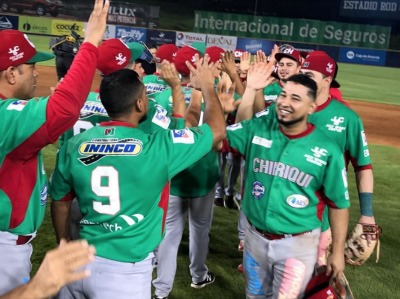
Its happening April 27-29, 2018
Sadly, our team Chiriqui Occidental (of Puerto Armuelles) didn't make into the final series, but Chiriqui (of David) did.
Chiriqui is battling it out with Bocas Del Toro. The team who wins 4 out of 7 games is crowned champion.
After 4 games it was 2 and 2! But in the end, Chiriqui lost the championship to Bocas del Toro.
Chiriqui really wants to win this championship. They were the champions in 2016.
Then Colon beat Chiriqui to win last year's championship. But I must say Colon deserved the win. It was the first time in 54 years that Colon won the championship.
Regardless, Chiriqui wanted the title of champion back in 2018.
Chiricanos (people from Chiriqui) are very proud of their province. And they have many reasons to be proud. One being baseball.
Chiricanos are very very good at baseball. You won't make any friends rooting for a rival team.
Carlos Ruiz - Major Leaguer
In fact, one of David's prodigal sons, Carlos Ruiz, played in these 75th Championship games. Ruiz is a catcher in US Major League Baseball. He started with the Phillies, then went to play for the Dodgers, then the Mariners, and is now a free agent.
Ruiz is the only player in the history of the National League to catch four no-hitters, and 1 of only 2 catchers in Major League Baseball, the other being Jason Varitek. (source: Wikipedia).
Baseball in Panama has two leagues, Juvenile League and the Panamanian Major League (AKA Panama Baseball League).
Each of Panama's 10 provinces has its own Juvenile and Major League baseball teams. However, Chiriqui is so good at baseball it can field 2 teams: Chiriqui Occidental (Puerto Armuelles) and Chiriqui Oeste (David).
Not even the Panama province has 2 baseball teams and it is hands down the most populous province in the country. (FYI- The province of Panama's team is called Panama Metro.)
In the Major League, the Panama Metro team wins many championships, Herrera is often a contender, and Chirqui continues to hold its own.
The 11 teams are: Bocas de Toro, Chiriqui, Chiriqui Occidente, Colon, Cocle, Darién, Herrera, Los Santos, Panama Metro, Panama West, and Veraguas.
Well, actually, 22 teams if you count both the Juvenile and Major league teams. And they both should be counted. Panama takes its juvenile league very seriously.
TIP: One quick way to start a friendship with a local Chiricano is to ask about their baseball team.
As it turns out, baseball was not introduced to Panama by the Americans who came to build the canal. It started well before then. Baseball has been played in Panama as far back as 1883 when Panama was still a province of Colombia.
On Jan. 9, 1883, Panama’s Daily Star and Herald described a baseball game played in Chiriqui Plaza 2 days before. It was between a team from Chiriqui Province and members of the Panama Cricket and Baseball Club. (See Chiricanos have had a very long love affair with baseball). The Cricket and Baseball Club won. That team was mostly made up of West Indian workers brought in during the failed French-managed canal construction.
However, Panama's baseball history may go back even further. Back to a time before Amerca had even standardized rules for baseball. In his book, Historia del Béisbol Panameño, the Panamanian historian Ramon G. Pérez Medina writes that the 1st baseball game was played in Panama in the mid-1850s. One team was made up of American traders and the other team was men affiliated with the Panama Railroad Company.
In 1945, the Panamanian Major League was created. As I mentioned, the league has 11 teams: Bocas del Toro, Chiriqui, Chiriqui Occidente, Colon, Cocle, Darién, Herrera, Los Santos, Panama Metro, Panama West, and Veraguas
The first Panamanian to join an American Major League Baseball team was pitcher Humberto Robinson, who debuted with the Milwaukee Braves on April 20, 1955. Including the 4 major leaguers who were born in the Canal Zone, Panama has sent more than 50 players to the U.S. majors. That total includes recent players: Ruben Tejada, Christian Betancourt, Randall Delgado, and Carlos Ruiz.
Find out about the 10 Best Panamanian Players in MLB History, here.
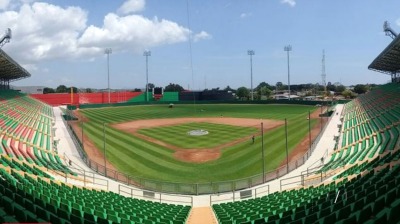
The Kenny Serracin Stadium in David, Panama is brand new.
It had its first game on March 23, 2018. And Chiriqui won!
(David is the capital of the Chiriqui Province)
Chiriqui was playing against one of their top rivals Herrera. Huge celebrations ensued!
The stadium has seats for 8500 fans. The old stadium only accommodated 2000 people.
It is all tricked out with lights and modern boxes. It was built to comply with the requirements of a Major League stadium in the States.
Where is it?
It is easy to find. It is pretty big.
It is by the intersection of the Interamericana and the overpass of the new road to Boquete. Another way to think about it, is that it is close to the Super Baru, the supermarket. Or better yet, punch the address into WAZE.
The Address
Calle P Norte (e / Av. Obaldía and Vía Belisario Porras)
David ,Chiriquí
About Kenny Serracin - the Man
Kenny Serracin is from Puerto Armuelles! (which is where we live in Panama). That is where he learned to play baseball. He also worked picking bananas in the banana plantations near Puerto Armuelles. Mr. Serracin later moved to David, where taught PE at a school in Doleguita. He then worked as the administrator and sports director of the original baseball stadium.
All the while he continued to play baseball. He was playing for Chiriqui when it won its first championship in 1944.
He was a man who worked for the love of the game.
In the 1970s, after he stopped playing ball, Mr. Serracin worked with the Lions Club to form little leagues teams and he helped to reorganize baseball throughout the province.
[leadplayer_vid id="5ACF9FB62ADFA"]
You may have heard that our beach town, Puerto Armuelles, Panama has some big news.
After many, many years of complete neglect, our airport is being entirely renovated.
And officials have even told us that there will be domestic commercial flights flying in and out of Puerto.
This is Betsy of Living in Panama. The place for information and advice on being an expat in Panama. Interested? Click subscribe and hit the bell, so you don't miss a video.
Recently, Puerto’s Mayor explained we will have a new runway, all new buildings, and a much better security fence. But better than the one you see here.
And let me tell you, there is nothing like taking a video to get all the officials in charge to come talk with you, which is what happened to me.
While we talked, these government officials told me, that 1 year from now Air Panama will offer flights into and out of Puerto Armuelles from Panama City, David & Bocas.
The officials seemed very certain that Air Panama would offer flights into and out of Puerto. Only time will tell if it really happens, but it seems possible. The President of Panama has already visited Puerto 3 or 4 times about the airport renovation.
Sadly, the airport renovation does mean that the community will lose a much valued exercise and open space. Right now, most evenings and early mornings, you will find many people on the airport runway and surrounding fields. They walk, run, play soccer.
You will also see horses on the airport a lot. Even in this photo, you are seeing horses, even while demolition is underway.
And it looks like, I didn’t actually check, but it looks like they have already demolished the airport’s 9 hole golf course.
It was pretty incredible that there was a golf course at the airport.
I'm really hoping that the renovation moves as fast as the officials I talked with anticipate. And, I have to say, that so far, at least during this demolition stage, the work seems to making rapid progress.
The airport is good news, both for the economy and for convenient travel. And once there are commercial flights here it will be much easier and faster to get to and from Puerto Armuelles.
Currently, the fastest way to get to Puerto is to fly into David, which is a little more than an hour drive away. And get
then get transportation from there.
If you haven’t heard of Puerto Armuelles yet, it is a charming beach town on the Pacific Ocean in the Chiriqui Province of Panama. Chiquita Banana built this unique and historic town starting in the 1920s.
For more information about Puerto Armuelles, click here.
You can explore our beautiful beach property for sale, by clicking here.
And again, this is Betsy Czark of LivinginPanama.com. Thanks for watching
Updated: July 28, 2019

My screen was a mass of colorful lines in motion.
Very pretty. But useless as a phone.
I felt disconnected from the world.
Cell phones are the easiest way to connect with friends and family - no matter where you are.
For people newly transplanted to Panama, having that connection is very important. It will help you feel less lonely and alone as you find your place in your new country.
I strongly recommend that you figure out your phone situation before you move to Panama.
An aside: When my iphone died (above), I bought a refurbished one off ebay and had it sent to me in Puerto Armuelles. Shipping to Panama cost only $13! I used Hot Express. Find out more about getting products mailed to Panama.
Your 1st step is to decide on the cell phone you will use in Panama. If you use your current phone, know that paying your plan's expensive international roaming charges is not your only option.
Luckily, it is easy to avoid paying those high roaming charges.
You have 3 options to avoid paying international roaming charges while in Panama.
This is a good option. Having an unlocked phone allows you to buy a SIM card from the provider of your choice and start using their service.
One of the main advantages of using your current (and unlocked) phone while in Panama is you will have access to all your contacts and other information that you store on your phone. This makes life a lot easier.
What is an unlocked phone? If you signed a 2-year contract to get a cheaper phone, it’s probably locked. Which means it will only work with your current service provider. However, most phone plans these days don’t require a contract. When you have an unlocked phone you are free to use any service provider.
Some background info: A SIM card is the little chip your service provider gives you. It is inserted into your phone and determines your phone number. You need a new SIM card whenever you change service providers.
Thankfully, the SIM card is independent of your phone storage. Changing your SIM card does not affect any of your contacts, photos, apps and other information you have stored on your phone. Which is why unlocking your phone is the best option. You can keep all your info, even as you change to a new provider in Panama.
Keep in mind, to use a SIM card, your phone must use GSM technology. Your phone probably uses GSM. Most phones in the world do. There are some phones in the US that do not. They use CDMA technology. For example, Verison, Sprint, and US Cellular have CDMA phones. But these companies have been switching to GSM or Universal phones. Universal phones accommodate both technologies.
The best way to get an unlocked phone is to get your current phone unlocked, if it isn't already.
It is easy to unlock your phone.
For instance, back in 2015, the USA passed a law requiring providers to unlock customers' phones upon their request. However, the company is only required to do so if you don't owe money on your contract or phone.
1. Call your provider. Don't go to your nearest cell phone store and ask them to unlock your phone. They most likely won't be able to help you. You need to call the 1-800 number for your service provider. Explain to them that you need it unlocked so you can use a local SIM card in Panama. Don’t let them talk you into signing up for their international roaming plan. Those are almost never a good deal. Once they do their part of the unlocking process, they will give you a code or a few things to enter into your phone for the unlock to take effect.
2. Online unlocking services. There are plenty of services available online that will unlock your phone. For instance, ebay features a few. Check their reviews to choose a good one.
3. Unlock in Panama. Most locations have someone who can unlock your phone. However, I'd recommend getting it done before you come to Panama.
We always buy unlocked phones. We usually buy them refurbished on eBay. It is my favorite way.
You can also buy an unlocked smartphone in Panama. One option in Panama is to buy an Android smartphone that takes 2 SIM cards. The dual SIM card option enables you to use 2 different Panama service providers. If you don't have coverage with one provider, you could switch to your other SIM card provider. (Maybe you can do this in the States as well. I don't know. So far, I have only used iPhones.)
Please buy a smartphone.
Not a simple phone that can only call and text.
People in Panama do not text, they Whatsapp.
Whatsapp is a messaging app only available on smartphones. Find out about Whatsapp here.
Sending a normal text in Panama is expensive because unlimited texting plans do not exist. Which is why everyone communicates with messaging apps - esp. Whatsapp - that use data plans.
You really should download Whatsapp before you come to Panama.
If you use Tmobile, then you don't have to make any changes to your phone or phone service at all. You can just continue to use your phone with your TMobile service.
TMobile offers unlimited texting and data (3g only) in Panama (and in over 210 other countries). The data service can be slow in Panama since they do throttle the data. TMobile says they don't throttle data in the US, but I cannot confirm that.
(Note: TMobile usually has a cheaper plan for people age 55 or older. Something to check out.)
TMobile also charges a somewhat reasonable rate for phone calls made while in Panama: $0.25 a minute. However, a better choice is to use WhatsApp, or other wifi based call app, for your calls and then you can avoid those roaming charges.
(Below, I list other free or inexpensive video and calling methods you can use to keep in touch with family and friends back home.)
You pay the same amount for your TMobile service whether you are in Panama or in the US. Well, except for any phone calls you make while overseas.
However, if fast Internet on your phone is important to you, you should get an unlocked phone and a local service provider. Your data speed with TMobile will be fine for texting and calls, but you won't be able to stream or do other high-load activities.
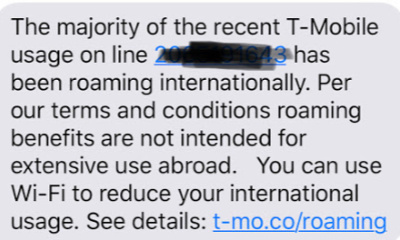
Another point against Tmobile: It does not like its customers to use data overseas on a long term basis. If you use Tmobile as your provider while living in Panama, they will continually remind you should not do that. (See the photo)
Tmobile states that using over 50% of your voice or data off-network (as in use in Panama) for an extended period of time is a violation of its Terms and Conditions. They also state that if you are in continual violation it will affect your service.
Once you have your phone choice all settled, you need to decide which service to use. As I mentioned, using the international roaming option with your current provider is usually an expensive option. Unless you use TMobile, and that has its limitations, as I discuss above.
Local Service Providers
Movistar, MasMovil, Claro, Digicel, Cable & Wireless are some of your service options.
How well a cell service works in Panama depends upon your location. You should ask people in your area of Panama about which provider works the best there.
You can easily switch providers if it doesn't work out. It will only cost a $3 SIM card. Make sure to ask your new provider to port your number to their service.
How To Use A Local Provider
Panama's Main Cell Service Providers
Our Opinion
Personally, we like Movistar the best. One of the biggest pluses for me is that its data seems to be faster and more available than MasMovil. Most people I talk to agree with my assessment. Keep in mind, I have never used Claro or Digicel, only MasMovil and Movistar.
You can buy minutes and Internet as you need them via pre-paid cards or by signing up for a monthly plan. Your choice will depend upon your needs and preferences.
You can buy minutes as you need them. You simply buy a prepaid card. You can buy these cards at grocery and other stores.
Ask for a "tarjeta de (your provider)". Tarjeta means card.
The cashier will ask you what value you want on your card. I have the best luck using $5 cards. I don't know why, but often when I try to input a card with a higher value I have more difficulties. You may not find that true.
Instructions for inputting your minutes are on the back of the card. The instructions are in Spanish. It is very simple.
Listen to the recorded message that plays right after you hit "send". It will be in Spanish. But if you hear the value you input, "cinco balboas" for $5, that means it worked. If it didn't, do it again. It will probably work the on the 2nd try. It usually does.
You can input a new card into your phone when you run out of minutes or you can recharge your phone online. Your provider will most likely text you instruction on how to add more minutes to your phone online. If not, you can ask someone, or look on your provider's website.
Minutes Expire
Once you input the minutes into your phone you have 2 months to use them. Any remaining minutes will expire.
However, the clock does not start running until you input the minutes into your phone. It is good idea to have an extra card on hand for when you unexpectedly run out of minutes, or when you re-enter Panama after some time away.
Internet - Pay As You Go
You can also use these prepaid cards to input data on your phone. It is not the best method if you are going to need data on a regular basis, but it works for your short-term needs.
Technically, you can automatically use your minutes for talking or internet use, but I find it works better if I explicitly ask for the data. Plus, it means you will save that value for internet alone, and it won't be used up by a phone call.
Typically, after you input your minutes, your provider will send you a text telling you how to convert those minutes into data. But not always. Here is what you do.
After hitting send, you’ll be guided through an on-screen setup process asking what you want to buy and how much of it you want. It is all in Spanish, but it is easy to figure out. Basically, you want to respond that you want a "paquete de datos" and yes, you want to buy ("comprar") whichever packet of data you selected.
All the providers offer a monthly data/talk/text plan.
The price depends upon the amount of data. No provider offers unlimited data plans.
Visit their offices or websites to get more information on what each plan offers. You can only start your plan in person, by visiting one of your provider's service stores.
My Local Monthly Plan
I have a monthly plan with Movistar that costs me $17 a month. They have less expensive and more expensive plans than mine.
To set up my plan, I needed to visit an official Movistar office in person. It was easy to do and the gentleman who helped me spoke English well.
I have never used my online Movistar account. The only thing I can use it for is to change my plan. I cannot start or stop my plan online.
No Contracts
Typically there are no long-term contracts (or any contracts) required for service plans in Panama. They are all monthly plans that you can cancel at any time.
But you cannot cancel your plan online. At least not with Movistar. You will be told that you must visit the office, in person, to cancel your plan. However, most companies, also have the option to text in an order to stop. They will not volunteer this information usually, you must ask.
So make sure to ask what to text to cancel your service. This is a good thing to know if you will be leaving the country for a month or more. Otherwise, you will be paying for Internet even when you are not in the country. Of course, even that it a pretty reasonable cost, (mine is $17/m0, Reyn's is $7/mo), it isn't much of a hardship.
Some local providers & your "home" provider offer international calling plans. However, before you spring for one of those, keep in mind there are many free ways to call internationally using wifi or by putting data on your phone.
Below are 5 options easy ways to keep in touch with friends and family back "home".
You can even buy an international calling card, available at most of the same places that the prepaid cards are sold. You buy a specific number of minutes and follow the directions on the card to use it to call internationally.
I'd recommend setting up all 5 of them. They are each useful in different situations. Plus, various people in your life will prefer one over the other.
It is pretty easy to set up a cell phone in Panama. If your first provider doesn't work out, it is pretty easy to switch. A SIM card only costs about $3.
Your whole communication set up will work better if you have a smartphone.
At this point, if you have somehow avoided buying a smartphone, congratulations. That is quite the accomplishment. But you might want to make the leap before you move to Panama. Having a smartphone will make communicating both with people in Panama and back home much easier.
For instance, almost everyone in Panama uses Whatsapp to both call and text. It is a great app. If your friends and family back home don't have it yet, encourage them to get it. It will allow you to communicate with them for free, if you both have the app. It really is a wonderful app. Find out about Whatsapp here.
And there are just so many other apps you can get to improve your communication as well as your entertainment. I will discuss those in a future post.
In Puerto Armuelles and have a cell phone problem? Maybe you cannot download an app, get data on your phone, or it keeps freezing, or whatever. Check out Genius Place, a cell phone & technology store. They may be able to help you out.
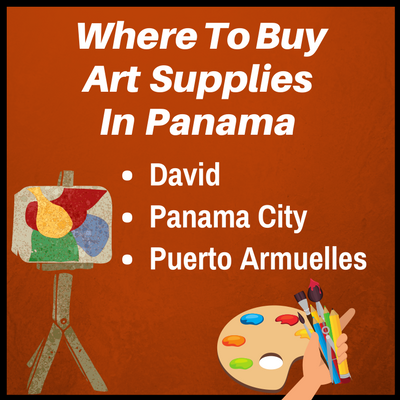
You can find craft and art supplies at many stores in Panama. However it isn't necessarily of the best quality, especially the paints. Although, Panama City does have stores which sell higher quality paints and other supplies.
You can also order higher quality supplies online and get them shipped to you in Panama. Check out this link on getting online purchases delivered to Panama.
Painting Canvases
Before I list the places where you can buy art supplies, I wanted to say a word about canvases for acrylic paintings. You can buy pre-made canvases at many of the stores listed below. However, you can also easily make your own.
To make your own painting canvas, the fabric to use is called manta sucia. It is a very affordable light cotton duck fabric. It is available at any fabric store. You can make the frame yourself or have it made at any woodworking shop. Then stretch the fabric onto it using staples.
This is not a comprehensive list of all the places you can buy art supplies. However, it includes some of your better options.
More Resources in Puerto Armuelles
Learn about art classes, workshops and more available in Puerto Armuelles.
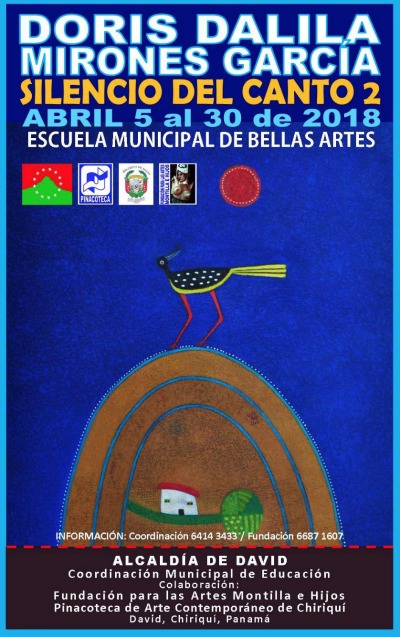
More Resources in David
Pictured is the poster for an upcoming show. It opens an April 5 and closes April 30, 2018 The show is co-sponsored in part by the Fundacion para las Artes Montilla e Hijos and Pinacoteca de Arte Contemporaneo de Chiriqui. Both are Chiriqui focused art organizations. Call 6687-1607 for more information or to learn of up coming shows.
More Resources in Panama City
Master net is a craft/art store with classes. You can find out more on their facebook page: facebook.com/masternetpty It is located in El Carmen, calle del Teatro En Circulo, next to ScubaPanama. +507 261-8995/
Panama City has a Museum of Contemporary Art. For more info, check out their website: macpanama.org.
Please contact us or leave in the comments your favorite art supply stores, art museums and galleries, or other art resources in Panama.
Creativity is inventing, experimenting, growing, taking risks, breaking rules, making mistakes, and having fun - Mary Lou Cook
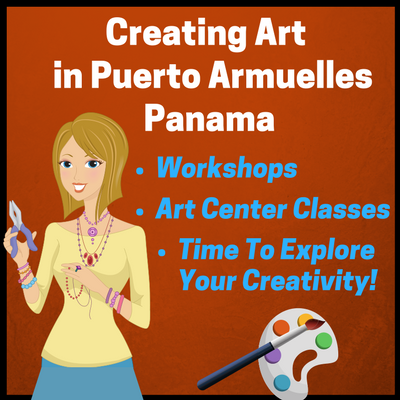
Art is something that some expats in our beach town, Puerto Armuelles, are actively pursuing.
In fact, recently we had one expat ask about where to buy acrylic paint to use in her craft projects. The next day, another expat asked what art classes were offered at Puerto's Centro de Bellas Artes Verisimo Castillo (Verisimo Castillo Center for Fine Arts).
In this post, we discuss the art classes offered, and other art opportunities offered in Puerto Armuelles.
We answer the question of where to buy art supplies, such as acrylic paint, in another post. (See the link below)
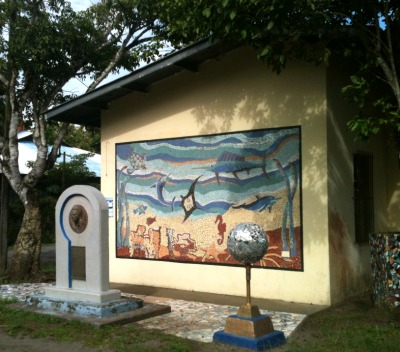
Puerto's Art Center: The Centro de Bellas Artes Verisimo Castillo. Bellas Artes offers classes for both adults and children. At various times of the year they offer classes in drawing, painting, guitar, and traditional dancing. Their main focus is on painting; acrylic painting.
These classes generally take a break in order for children to take classes during their summer break (January and February) and other school holidays.
Our daughter Skylar took a few art classes at the Centro de Bellas Artes when she was much younger. Then when she was 10 or 11 years old she attended afternoon painting sessions, which at the time were held every weekday afternoon. It was an adult class, but they were fine with her attending.
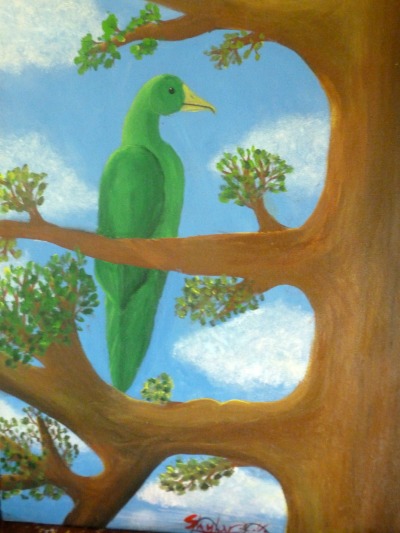
You can see one of the paintings she created during those sessions. Over the years, Skylar has also taken guitar lessons at the center.
Currently, there is a painting and drawing class in session. It runs from March - June 2018. It meets once a week, on Friday, at 4:30pm. The fee for the course is $30. The next session is expected to begin in July. The classes are all taught in Spanish.
You can also put your own group together for a class or drawing/painting group. The Director of the Center, Professor Carlos Miranda, is open to making that happen. The Center has easels and other art supplies available for your group's use. There will, of course, be a fee to use the space and their supplies.
For more information, you can stop by the Center or call the office at 770-7380. You can also reach Professor Miranda directly at 6665-5324. FYI, very little English is spoken at the Center.
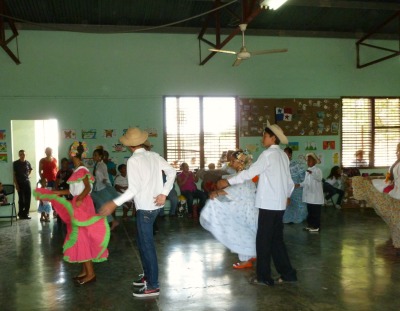
The Bellas Artes building is located next to the Las Palmas baseball field, on the road to the Las Palmas neighborhood. It is shown in the photo.
Art Workshops. Brenda, an expat and one of the owners of the Tsunami Inn, offers workshops using Polymer clay, mosaics, and more. She is interested in creating art out of glass bottles and anything she is inspired by.
Her husband Don recently built her an art studio which includes a nice-sized kiln. That is where the workshops take place. I took one of her Polymer clay workshops recently. It was very enjoyable & educational.
Check back here or on the Puerto Armuelles Friends FB page for announcements of upcoming workshops.
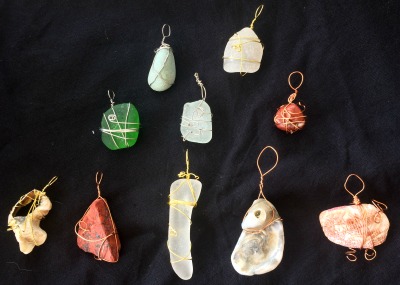
Jewelry Making & Crafts. Every other Tuesday there is a jewelry/craft making opportunity at an expat gathering in the Coronado neighborhood. The other Tuesdays you can enjoy playing scrabble, as well as swimming in the pool or in the ocean. Here is some jewelry that was made on one such Tuesday.
Children Music Lessons. There is a musician in the Pueblo Nuevo neighborhood who for many years has offered music lessons and appreciation to kids in Puerto Armuelles. The drop in music experience is every Sunday afternoon. You will see him hanging out on his porch. Pueblo Nuevo is a tiny neighborhood behind the police station. Just after you pass the police station, his house is on the left, just before you are forced to turn right to avoid going the wrong way on a one-way road.
Puerto's Flea & Craft Market. You can sell your art at our monthly (more or less) market. It is held at the downtown waterfront park. You can sell your wares at the market even if you have no work permit. It is legal as long as any income generated is a minor part of your total income.
If you want to sell your art, crafts, or your stuff at the market & have Whatsapp, please contact us. I will ask if you can be put on the Whatsapp group. The Whatsapp group is for people who will plan on participating in the market. So only make a request to be part of the group if that is your serious intention. As a vender will be asked to donate part of your proceeds to help the street animals of Puerto Armuelles.
Do you know of any other art opportunities in Puerto? Please let me know.
Art of all types can be fun, especially when there are other people inspiring you with their art - or their attempts at art.
If you want to put your hat in the "art" ring, you may want to contact Brenda of the Tsunami Inn. She is interested in helping people explore art, of any type. Many people have never had the opportunity or time to explore their creative instincts. Now that you live in Puerto Armuelles, that has changed. You now have time to dabble and explore different mediums. You may find you have an unrealized talent. Something to pursue in this next chapter of your life.
If you have information about an art opening, where to find the best deals on artists supplies, or what crafts you are making to sell at the Saturday Flea Market, please comment below. We would love to hear from you.
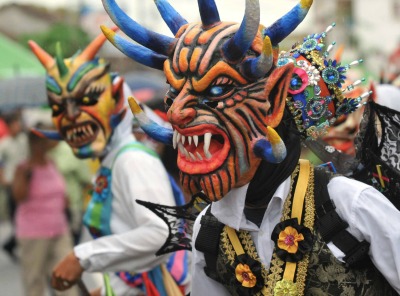
Wherever you go, there will will be alot of smiles, music, dancing, and drinking.
In the bigger celebrations you will find:
When is Carnival? Carnival is from Feb 10 - Feb 13th. Feb 13th is also called Fat Tuesday and is the biggest day of the celebrations. The next day, Feb 14th, is Ash Wednesday and the start of Lent. (Lent is a period of fasting and devotion leading up to Easter per the Catholic Church.) This year the start of Lent is also Valentines day.
Las Tablas hosts the most extravagant carnival celebration in the country.
The parade they put on is given alot of spice because of the rivalry between two streets, Calle Arriba and Calle Abajo. Each street vies to put on a more grandiose show. Each street also has it’s own carnival queen, each one try to out shine the other.
The Las Tablas carnival is featured in the 2017 movie, Donaire y Esplendor, by Arturo Montenegro.
Santo Domingo is a little town about 5 minutes from Las Tablas. They have a good parade featuring traditional dress and dance. The parade is in the late afternoon, on Tuesday.
Most people leave Panama City for Carnival.
Read this post, which includes critical info about travel to and from Panama City during Carnival.
If you stay in Panama City, the places to go are the Cinta Costera and Avenida Balboa. A procession of floats, dancers and revelers create the city’s biggest street party of the year.
You can find plenty of food and drink at the numerous stalls along the way. There’s live music, face painting for the kids and a whole lot of dancing. (Remember, you will get wet. So don't wear anything you want to keep dry)
Arrive early in the afternoon if you want any hope of being near the parade procession. The parade gets into full swing alittle after sunset.
I'm told that the Diablico Sucios in Bocas carry real whips that they use on anyone they determine are "misbehaving. Most of the festivities occur on the main street of Bocas town on Isla Colon.
Penonome puts on a more family-friendly carnival celebration. They also have a very unique feature. Their Carnival parade is on the water. The floats, literally float.
Chitre's carnival celebrations are second only to the famed celebrations of Las Tablas. They feature the typical parades, folkloric dancing, and water fights.
We have been in Chitre for carnival. We enjoyed it. We stayed at a hotel right on the square. The hotel's balcony was an excellent place to experience the carnival, esp. once we were ready to retire from the street experience.
Pedasi, is a small town near the beach in the Los Santos province of Panama. It is not far from Chitre. It has an even more mellow carnival experienced than Penonome. The festivities are mostly in the central square. Bring a chair and a cooler and relax and enjoy the parade, music, and crowd.
For some reason, this village's carnival celebration is very popular with Panamanians from all over the country. So much so that the village lives mainly off the revenue that is generated during carnival.
It is laid-back celebration with a “moving carnival” that has people dancing with the band as it moves from house to house. It also has the usual parade and the competition for the title of the beauty queen. It is about a 50 minute bus ride from Chitre.
The Chiriqui Province is not a place to go for an exceptional carnival experience. I live in Chiriqui, so I feel I must mention it.
In Puerto Armuelles, where I live, it is mostly a family affair. Many locals tend to make a weekend of it by going out to the beach and bars out on Punta Burica. The bars will have more live music and will generally be livelier and more crowded. The waterfront bar Tisa Mar, in particular, usually has live music and charges admission.
Dolega, David, and Las Lajas, all in Chiriqui, have carnival celebrations. David has the biggest one of the three, which isn't saying much.
Until 2 years ago, David hadn’t celebrated Carnival for 16 years. Now they do celebrate Carnival, but I think it is still only during daylight hours.
Last year, I wrote a more detailed post all about Carnival.